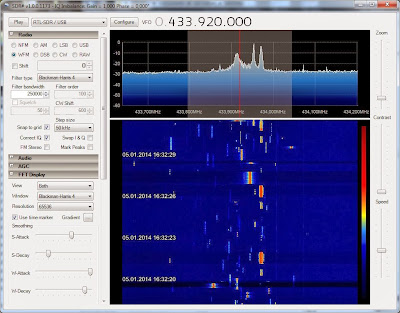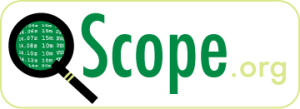Posts Tagged ‘SDR’
 CommRadio CR-1a another SDR that looks interesting
CommRadio CR-1a another SDR that looks interesting
I have never really spent much time on the Software Defined Radio arena, but the more I keep loo at them they are becoming so interesting. The CommRadio CR-1a communications receiver is a true SDR (software defined radio), but does not require a computer. Enjoy the benefits and performance of state-of-the-art SDR, but in a conventional radio package.
As much as I hate to say, it might be time for me to make a purchase and spend some time playing with these. I really like the size of the rig in comparison to the SunSDR2 (http://nicktoday.com/sunsdr2-sunsdr-mb1-transceivers-software-defined-radios/). Hard to tell until I see them both in person.
Full story: http://nicktoday.com/commradio-cr-1a-another-sdr-looks-interesting/
 Video of busy 70 cm ISM band due to car key fobs
Video of busy 70 cm ISM band due to car key fobs
Data recorded from an RTL-SDR USB dongle with the SDR# program using the Apowersoft Free Online Screen Recorder.
Related posts:
- “Car keys in the 70 cm band” (with more documentation of hardware and software)
- “Not so busy 70 cm ISM band”

 Not so busy 70 cm ISM band
Not so busy 70 cm ISM band
Yesterday’s post entitled “Car keys in the 70 cm band” showed a very busy band around 433.92 MHz with up to 10 simultaneous transmissions. That snapshot was taken on a Sunday afternoon at 16:32 local time. Here is a much less crowded snapshot taken with the USB SDR-RTL dongle under the same conditions as the previous blog post. The difference is that this is from late Monday night at 23:34 local time:
 |
| Press image for a larger view |
Thanks to all viewers who have made the former blog post the most popular on my blog for this week. Thanks also to the RTL-SDR blog which gave it publicity in the blog post “Looking at the 432 to 438 MHz ISM band“.
Related posts:
 Car keys in the 70 cm band
Car keys in the 70 cm band
 |
| Press image for a larger view |
Related posts:
- “Not so busy 70 cm ISM band” showing the status on a late Monday night
- “Video of busy 70 cm ISM band due to car key fobs“
 Where to find the $20 Software Defined Radio?
Where to find the $20 Software Defined Radio?
A while back I wrote a blog post about the availability of $20 software defined VHF/UHF radios in the form of re-purposed USB digital television dongles.
Now-days, with the improvements in software and documentation, the hardest part is finding the right dongle. What you order from EBay, and what you receive, can be two different things and only some of the dongles are suitable for use as VHF/UHF software defined radios.
So, I was pleased to see that at least one hobbyist electronics supplier has sought out and supplies a suitable device for SDR at a fair price :
Adafruit has available the USB dongle and “antenna” suitable for experimentation for $22.50, not far from the EBay (direct from China) price.
Click here to go directly to the product page: Software Defined Radio Receiver USB Stick – RTL2832 w/R820T
No, I didn’t receive a free evaluation unit and I don’t work for Adafruit … I’m just glad to see these useful devices available from a local company with an increased chance of you “Getting what you paid for.”
Adafruit also helpfully stock the adapter cables to convert the less common MCX antenna connector into the much more common BNC connector: MCX Jack to BNC RF Cable Adapter
 Show Notes #113
Show Notes #113
Episode #113 Audio (Listen now!):
- New look for the web site
- Linux Professional Institute puts Linux in the classrooms
- Linux turned 22 y.o. this past August 25th.
- Radio Talk 2013 – Ham Radio event reinvents itself
- http://radiotalk2012.wordpress.com/ (yes the 2012 in the url is supposed to be there)
- UK funeral interrupted by RF
- QScope
- twHamQTH 1.3 release
- Next LHS Live our special guests will be Richard & Brady from the LowSWR podcast
- Social Media Roundup
- Twitter
- Steve B – @RigolHam
- Allen G – @VA4AJG
- Facebook
- Daniel F.
- Twitter
- Subscribers and Donations
- Daryl O. – Yearly
- Michael S
Feedback
- E-mail from Serge S. (ON4AA)
Outro
- Thank you to our monthly and yearly subscribers.
- Thank you to all of our listeners, live and quasi-live.
- You can reach us at [email protected]. You can leave us voice mail at 1-909-LHS-SHOW (547-7469).
- Please subscribe to the mailing list.
- Go to CafePress and Printfection and buy some of our show merchandise. Each purchase helps out the show.
- Listen live every every other Tuesday at 8:00pm Central. Our recording schedule is on the Web site.
- “Save You” by Circus Underground from the EP Circus Underground, courtesy of Jamendo.
- “Engulfed” by Sonorant from the EP Engulfed, courtesy of Jamendo.
 LHS Episode #113: Eye to the QScope
LHS Episode #113: Eye to the QScope
 Yes, that's right: It's another brand-new episode of Linux in the Ham Shack! We know it's been a while since your RSS feed has been filled with the joy of our show, but we're back and aiming to stay on track (now that Richard is safely tucked into his cardboard box again). In this action-packed installment, your hosts discuss promoting Linux in the classroom, a wedding interrupted by a radio transmission from above, WA0EIR's updated suite of Open Source ham radio tools, and a novel analytics tool for hams called QScope. See you all down the dial very soon!
Yes, that's right: It's another brand-new episode of Linux in the Ham Shack! We know it's been a while since your RSS feed has been filled with the joy of our show, but we're back and aiming to stay on track (now that Richard is safely tucked into his cardboard box again). In this action-packed installment, your hosts discuss promoting Linux in the classroom, a wedding interrupted by a radio transmission from above, WA0EIR's updated suite of Open Source ham radio tools, and a novel analytics tool for hams called QScope. See you all down the dial very soon!
73 de The LHS Guys












